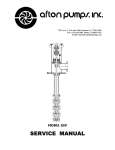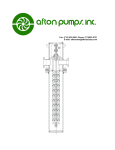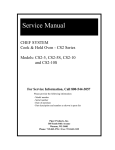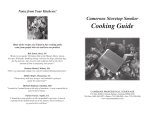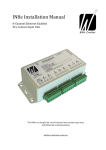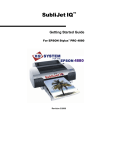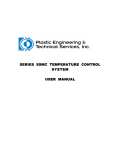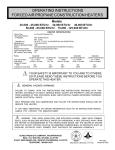Download SERVICE MANUAL
Transcript
SERVICE MANUAL MODEL ILVS 7335 Ave. N, P.O. Box 9426, Houston, Tx. 77261-9426 Fax: (713) 923-3902 Phone: (713)923-9731 E-mail: [email protected] SERVICE MANUAL GENERAL shipment is found to have been defective at the time it was shipped. INTRODUCTION: Afton pumps have been designed and tested to give dependable, trouble-free service with a minimum amount of attention. To insure dependable operation the pump unit must be properly installed, operated and serviced. Because of the variety of installations in which these pumps are used, this manual can only provide general information. For specific information not contained in this manual contact an Afton dealer. The Purchaser must give Afton Pumps immediate written notice upon finding such defect. Afton Pumps shall have the option of requiring the return of the defective material transportation prepaid, to establish the claim. Afton Pumps shall in no event be held liable for damages or delay caused by defective material and no allowance will be made for repairs or alterations unless made with its written consent or approval. Afton Pumps shall not be held responsible for work done, apparatus furnished, or repairs made by others. Warranty on equipment and accessories produced by other manufacturers is limited to warranty of the respective manufacturer. WARRANTY: Afton Pumps, Inc. warrants the equipment of its manufacture against defects in material and workmanship under normal use for a period of one year after date of shipment. The Company’s obligation under this warranty is limited, however, to furnishing or repairing, without charge, F.O.B. its factory, a similar part to replace any part of its equipment which within one year from date of There are no warranties, expressed or implied, except as stated in this warranty. Afton Pumps shall not be liable for any special, indirect, or consequential damages resulting in any manner from the furnishing of this equipment or for any damages of any kind arising from the use of this equipment. -CAUTIONMotor for this unit is designed to operate in a vertical position. DO NOT attempt to transport, install, or otherwise handle horizontally. Small motors, with grease lubricated bearings top and bottom, which were mounted on the pump at the factory, are an exception to this rule. DO NOT attempt to install or operate without reading this manual. DO NOT store this unit in an unprotected area. The unit was reasonably protected from field damage and rust prior to shipment, but extended unprotected storage will cause problems specifically in the coupling and mechanical seal areas. DO check for shipment damage and missing parts immediately upon receipt of equipment. All shipments are F. O. B. shipping point. 1 TABLE OF CONTENTS PAGE GENERAL/WARRANTY INFORMATION 1 TABLE OF CONTENTS 2 DISASSEMBLY, REPAIR AND REASSEMBLY INSTRUCTIONS 3-4 Driver Removal Mechanical Seal Repair Impeller Sub-Assembly Removal Ordering Parts TROUBLE CHECK LIST 5 INSTALLATION AND OPERATION 6 Suction and Discharge Piping Support Strainer Seal Piping Rotation Start-Up Lubrication ILVS SHAFT ALIGNMENT 7 ILVS CROSS-SECTIONAL 8 ENGINEERING DATA 9 Wear Ring Clearances Sleeve Bearing Clearances 2 DISASSEMBLY, REPAIR, AND REASSEMBLE INSTRUCTIONS FOR MODEL ILVS PUMPS I. Driver Removal: Close pump suction and discharge valves, vent case drain the pump (properly dispose all liquids), and disconnect power supply. Pump coupling is vertically split and bolted together. Split circular keys position the shaft vertically and the longitudinal keys transmit torque. All inner surfaces are held to a tolerance of. 0005. If pump has been in service any length of time, coupling halves may be stuck together. To separate loosen cap screws approximately two (2) turns and tap sharply on cap screw heads. Spraying with kerosene or light penetrating oil will help to separate the stuck coupling halves. DO NOT AT ANY TIME SEPARATE THE COUPLING HALVES BY DRIVING A WEDGE BETWEEN THEM. After coupling halves are separated and keys removed, unbolt driver. 1. To reinstall driver note the following: 2. Clean motor and cover faces, be sure fits are free of dirt, rust and burrs. 3. Apply light coating of grease to cover fit. 4. Replace driver on cover, bolt it down and check rotation. 5. 6. Before reassembling the coupling, be sure all parts are clean, well oiled and free of dirt or burrs. Line up the pump and motor shaft vertical keyways and install vertical keys. This can be done by applying a generous application of grease to the vertical keys. Install one half of the circular key on each shaft on the same side as the vertical key. Place coupling half so as to engage the vertical key and half circular key on the pump shaft. Use a screw driver or pry bar under the lower edge of the coupling at pump end and raise this half of the coupling, which, will also raise the pump shaft, until the coupling motor circular key groove and vertical key groove are aligned with the motor shaft vertical key and circular key. Push coupling half toward shaft center line to engage both keys. Then install other half of circular keys and coupling and bolt up coupling. (See tightening sequence “ILVS Shaft Alignment Page 7) 7. Unit should turn freely before valves are opened. 8. Vent pump before starting. II. Mechanical Seal Repair: Refer to page on ILVS shaft alignment if seal service has been unsatisfactory. If pump is equipped with shaft sleeve try to determine if liquid is coming from between shaft and sleeve indicating failure of sleeve o-ring. If this is the case, repair will require removal of pump from case. (See “Impeller Sub-Assembly Removal” below). Other seal problems can probably be handled without opening the pump case. 1. Close suction & discharge valves, drain, pump and disconnect power. 2. Remove spacer coupling, (detailed instructions above under “Driver Removal”). 3. Disconnect gland flush line. 4. Unbolt gland, lift up, and out. 5. Remove mechanical seal, (if pump has been in service for any length of time, sealing member, o-ring, u-cup, or teflon wedge may be stuck to the shaft. To remove insert two (2) hooks which can be made of stiff wire into stuffingbox under seal and lift). 6. Examine parts to determine cause of failure. It should be noted original clearance of shaft to stuffingbox bushing was approximately .006 to .008 (depending on pump size). Anything over approximately double these figures will result in rapid seal failure. If movement of the shaft indicates excessive clearance, here the pump wear ring(s) will also require replacement, which necessitates opening the pump case. Complete instructions for this are under “Impeller Sub-Assembly Removal” below. 7. Replace worn seal parts and reassemble. If seal has slot drive, be sure pins are properly seated. No mechanical seal adjustment is required. Be sure shaft is clean. If pump has tandem seal assembly, refer to detail drawings of mechanical seal. 8. Unit should turn freely before valves are opened. 9. Vent pump before starting. 3 III. Impeller Sub-Assembly Removal: 1. Close suction and discharge valves. Open pump drain(s) and disconnect power supply. 2. You may desire to leave the coupling made up with the cover connected. If so, removal of impeller sub-assembly can be accomplished by removing case nuts and lifting entire assembly straight up. There is a close metal to metal fit between case and cover. Do not get this fit in a bind. Use jack bolts to lift the cover out of the case. 3. Normally, problems requiring removal of impeller sub-assembly will require breaking the coupling. Complete instructions for this operation can be found above under “Driver Removal” 4. As mentioned earlier, wear rings and throttle bushings wear at approximately the same rate. Correct clearances for these members are shown elsewhere in this manual. All rings and bushings are pressed in place approximately .004 tight. 5. If coupling, shaft, impeller, and /or impeller rings were replaced, it will be worthwhile to place impeller on shaft and make up coupling to motor shaft without gland, cover, or case and check runout of wear ring fits. If this runout exceeds .002, disassemble and determine cause. Note impeller is keyed to shaft, impeller screw has right hand threads. 6. Replace all gaskets and o-rings if possible and clean all surfaces prior to reassemble. 7. If coupling was separated during repair, it will be to your advantage to assemble as follows: Note bushings and wear rings must be in place before assembly is started. a. b. Connect shaft (and sleeve if so equipped to impeller) Drop these into case g. h. c. d. i. j. e. Install case gasket Bolt cover in place Install seal and gland, (see “Mechanical Seal Repair” above) f. Set driver in place and bolt down Connect power and check rotation Connect coupling, (see detailed instructions above under “Driver Removal) Connect auxiliary piping (if so equipped) Refer to startup instructions on page 6 of this manual Refer to page 7 on ILVS Shaft Alignment if seal service has been unsatisfactory. IV Ordering Parts: 1. Specify pump serial number 2. Specify part name, (from drawing) 3. Specify any material or rating change desired CAUTION!! KEEP OIL LUBRICATED MOTORS IN VERTICAL POSITION 4 TROUBLE CHECK LIST Should you feel the pump is not doing the job for which it was sold a few simple checks and observations will help locate the trouble. To make these checks you will need a pressure gauge set at the pump discharge, an ammeter, a performance curve applying to the pump, and a pressure gauge set at the pump suction. ROTATION Unit rotation must be CW looking down on motor. NOISE & VIBRATION Does pump have either, at operating point and/or shut-off? (If so, do not operate until these conditions are corrected). Does unit rotate freely by hand? NPSH Is pump strainer plugged? Is vapor pressure above design? Is suction pressure low? DISCHARGE PRESSURE & AMPERAGE Check both with discharge valve closed one-half open, and fully open. VOLTAGE Must be within 10% of design? Is motor wired correctly? CORRELATE READINGS 1. A) Discharge PSIG x 2.31 Pumpage specific gravity B) Operating H.P. Motor Nameplate H.P. C) T.D.H. x Gal. Per Min. (2) 3960 x Pump Eff. (1) = Total Differential Head (TDH) approximately equals Amp Readings Full Load Amps x Specific Gravity = H.P. 1) From pump performance curve Read from pump curve and estimate with various valve openings If, after checking the above, you still feel the pump is not performing as it should, prepare to remove and dismantle. Should pump be in warranty. AFTON would appreciate the opportunity of discussing the unit with you prior to its removal. CAUTION! MOTORS SHOULD ACCOMPANY ANY PUMP SENT TO THE SHOP FOR REPAIR. BE SURE TO DRAIN OIL FROM OIL LUBE MOTORS PRIOR TO SHIPMENT. REMOVE ALL HAZARDOUS MATERIALS FROM THE PUMP BEFORE SHIPPING. 5 ILV & ILVS INSTALLATION AND OPERATION 1. Suction and Discharge Piping: All piping should be well-supported and as free as possible from unnecessary restrictions and bends. Possible air pockets on the suction side of the pump should be eliminated. It is recommended that the suction piping be one size larger than suction flange of the pump and reduced at the suction flange by use of an eccentric reducer. The straight side of the reducer should be on the topside of the piping. In no case should the suction pipe be smaller than the suction flange on the pump. Avoid positioning the pump at the highest point of a piping system where any vapor present would collect, thus inviting vapor locking. Sloping the suction piping will help avoid air pockets. 2. Support: This pump was purposely designed to eliminate the necessity of providing an extensive foundation. However, it is necessary that the piping immediately adjacent to the pump suction and discharge flanges be supported with conventional pipe supports. Units with a gross weight of 750# or more may require a simple support under the pump. 3. Strainer: In new installation, dirt, scale, weld slag, and other foreign material may get into the piping system. It is very important to prevent material from entering the pump. All new piping should be thoroughly flushed out before the pump is installed. Place a cone type strainer, which can be made of 1/4" mesh hardware screen, in the suction line as close to the pump as possible. As the strainer collects this material, it must be removed and cleaned. After several days in which the strainer collects no material, remove it permanently from the line. The total area of the screen openings should be at least four(4) times the flow area of the suction piping. 4. Seal Piping: In a normal installation where the pump is handling a clean product (other than water) at temperature below 350oF., no auxiliary piping other than that furnished by AFTON is required. For general information you will note standard construction calls for a seal flush connection piped to a discharge tap: (pumps with suction pressure above 300 psi will normally have the flush line connected to the drain tap which is under suction pressure). There is another tapped connection in the gland (or gland area on ILV pumps) labeled seal leakage drain on certified prints. In the event of seal failure, the liquid passing the seal will be restricted by the throttle bushing and pass out this connection which may be piped to a sump, flare stack, or seal shut-down device, if desired. If an operating temperature of above 200oF. was specified, the mechanical seal will have viton, teflon, asbestos, or some combination thereof for sealing members. These materials will perform with somewhat reduced life expectancy between 350oF and 400oF Above this temperature, rapid deterioration can be expected; therefore, it is desirable to cool the stuffingbox for temperatures between 350o and 400oF. it is normally considered mandatory. This cooling may be accomplished by use of a water jacket around the stuffingbox, or a cooled product injection to the gland flush connection, or both. API specifications require a cooled product injection to the stuffingbox at temperatures above 350oF. If a water jacket is provided, the standard flush line to the seal is omitted, and the flush connection is plugged. A valve should be installed at this point to properly vent the pump. The water (or product) used to cool the stuffingbox should be connected to the taps provided in the jacket. If a cooled product flush is used to reduce stuffingbox temperature, the gland flush connection will normally be plugged at the factory to prevent dirt from entering the stuffingbox area. It will, therefore, be necessary to take a product stream at a pressure of at least 10 psi in excess of pump suction pressure and a temperature not exceeding 400oF. (preferably approximately 250oF.) and inject this in the stuffingbox at the gland flush connection. One suitable method of doing this would be to take a line from the pump discharge through a cooler (air or water) and back to the gland. It may be necessary to restrict the flow by use of an orifice to allow the cooler to bring the product down to the 250oF. range. If the pump is to handle a dirty gritty product, it is considered mandatory to provide a clean flush to the stuffingbox. This may be done similar to the above method by use of a strainer or cyclone separator in lieu of a cooler. 5. Rotation: Rotation of AFTON In-Line Pumps is clockwise looking down on the unit. It is not desirable to operate the unit with reverse rotation for an extended period of time. However, no damage will occur if the unit is operated briefly to check correctness of wiring while coupled. The pump must be full of liquid and properly vented during this check. On close-coupled Model ILV pumps it will probably be necessary to remove the motor fan cover to determine rotation. On some models the shaft slinger can be observed. 6. Start-Up: Close discharge valve, open suction valve, open vent valve until a stream of liquid is observed, close vent valve, push the starter button, and slowly open the discharge valve while observing the discharge gauge. If a sudden drop in discharge pressure is observed, rapidly close the discharge valve and shut the unit down to determine the cause. When design discharge pressure is reached, immediately check current with an amperemeter and compare to nameplate amps. 7. Lubrication: None required by pump. Refer to motor manual for motor lubrication information. Oil lubricated motors are shipped without oil; customer must provide. CAUTION: NEW MOTOR DESIGNS CALL FOR REDUCED LUBRICATION INTERVALS. READ YOUR MOTOR INSTRUCTION BOOK. 6 ILVS SHAFT ALIGNMENT If a dial indicator reading of .003 (T.I.R.) or more is observed between the gland and the coupling (with the button resting on the shaft), there is a problem in the assembling of the coupling that will probably cause rapid seal failure. It should be noted that reaching the shaft in this area requires an extra long indicator button, and if this is not on hand, it should be obtained; but in the interim, a measurement of the runout of the coupling O.D. taken as low as possible on the coupling will be better than nothing. This runout should not exceed .002. Assuming either of the above runouts have been taken and are found in excess of desirable, proceed as follows: 1. Separate and remove both coupling halves and all keys. • 2. Carefully clean and polish motor shaft checking for burrs in the keyways, etc. 3. Check runout of motor shaft (maximum allowance .0005). This is important. 4. Lay a sheet of fine emery cloth on a perfectly flat level surface and rub each coupling half across the cloth to remove any burrs or nicks on these surfaces. This is very important in units where the coupling halves are in contact after installation. Not too important on units using the gapped coupling where the halves should be approximately 1/16 uniform space after assembly. 5. Emery all surfaces of each key in an attempt to remove any burrs or locate any distortion. 6. Emery the I.D. of each coupling bore and wash all parts, (coupling keys, etc.) in kerosene. 7. Reinstall coupling being sure to uniformly tighten all cap screws. ‚ 8. Recheck runout. 9. If runout still exceeds allowable, it may be necessary to disassemble unit and take pump rotating assembly (coupling, shaft, impeller, keys, etc.) to a machine shop. 10. Turn stub having exact same O.D. as motor shaft. Be sure you have miked motor shaft in at least three places and dimensions are uniform and shaft is within .0005 T.I.R. If this is not the case, the problem is in the motor shaft. 11.Without removing stub from machine, bolt pump shaft and coupling on stub and check runout. 12.At this point be sure to check pump shaft at several points to be sure it is not crooked 13. It is feasible to re-bore a coupling of the gapped design (coupling having the 1/16 face separation). Other couplings must have faces ground before re-boring. 14.If runout is still above .003, secure a new coupling. 15.After all parts are checked and found acceptable, reassemble unit. • Do not use screwdriver or steel wedge between coupling halves to separate coupling. Slight pressure on a pry bar under bottom of coupling to release weight on motor half split rings should allow the coupling to be separated. Occasionally a slight tap with a plastic hammer will be required to release one side of the coupling while pressure is maintained on underside of coupling. Keep the motor shaft set of split keys together, also the pump shaft split key should be kept together. ‚ Install vertical keys and split rings on both shafts, and align the vertical keys on pump and motor shaft. Take one half of coupling and install on pump shaft; at this point the motor shaft horizontal key should be aligned with coupling keyway but split ring motor shaft key will be higher than coupling split keyway. Use a pry bar under coupling. (not on shaft keyways) to raise pump shaft and coupling half until the split key on the motor shaft and the coupling split keyway are aligned. When this alignment is reached, the motor end of the coupling should slide into place. It may be necessary to use a slight tap with a plastic hammer to set the coupling half. When the first half is in place, the second half should easily be installed. Coupling bolts should be bottomed only in the following sequence: 5 8 1 4 3 2 7 6 After bolts have been bottomed, proceed to tighten in sleeve sequence. It is better to tighten each bolt a little at a time and in sequence, rather than all at one time in sequence. 7 PUMP PARTS LIST Item No. Description Item No. 1 PUMP CASE 12 2 13 PUMP COVER-(WATER JACKETED q ) x x 3 IMPELLER x 13-S 4 DRIVER SHAFT x 14 x(q ) 5 SHAFT SLEEVE-PACKING x 15 5-S SHAFT SLEEVE-SEAL x 16 x(q ) x 6 CASE WEAR RING x 17 x 7 COVER WEAR RING 18 x(q ) 8 IMPELLER WEAR RING-LOWER 19 x(q ) 9 IMPELLER WEAR RING-UPPER 19-S 10 IMPELLER WASHER 20 11 IMPELLER BOLT 21 q - OPTIONAL – CAN BE FURNISHED AT ADDITIONAL COST X – RECOMMENDED SPARE PARTS Description IMPELLER KEY STUFFING BOX BUSHING-PACKING STUFFING BOX BUSHING-SEAL GLAND BUSHING MECHANICAL SEAL CASE GASKET SHAFT SLEEVE GASKET LANTERN RING GLAND-PACKING GLAND-SEAL CASE STUDS & NUTS DRIVER BOLTS & NUTS 8 Item No. 22 23 24 25 26 x 27 x 28 29 x 30 Description SPACER COUPLING CIRCULAR KEY-DRIVER SHAFT CIRCULAR KEY-PUMP SHAFT STRAIGHT KEY-PUMP SHAFT STRAIGHT KEY-DRIVER SHAFT PUMP SHAFT GLAND O-RING GLAND STUDS & NUTS PACKING SET ENGINEERING DATA SECTION Wear Ring Clearances: The following data is in accordance with API 610 specifications and shall be considered an Afton standard where applicable. For cast iron, bronze, hardened 11 to 13 per cent chromium, and materials of similar galling tendencies, the following running clearances shall be used: Diameter of Rotating Member at Clearance (Inches) Less than 2 2.000 to 2.499 2.500 to 2.999 3.000 to 3.499 3.500 to 3.999 4.000 to 4.499 4.500 to 4.999 5.000 to 5.999 6.000 to 6.999 7.000 to 7.999 8.000 to 8.999 9.000 to 9.999 10.000 to 10.999 11.000 to 11.999 Minimum Diametrical Clearance (Inches) 0.010 0.011 0.012 0.014 0.016 0.016 0.016 0.017 0.018 0.019 0.020 0.021 0.022 0.023 Generally speaking, a wear ring clearance should be renewed whenever the initial clearance is doubled. Materials with severe galling tendencies such as 18-8 stainless steel will require increased clearances. Sleeve Bearing Clearances: Afton vertical pumps using pumpage lubricated sleeve bearings and throat bushings of bronze or carbon running against steel, 416, or 18-8 shafts (or shaft sleeves) shall have the following running clearances: Diameter of rotating member 0.075 to 1.500 1.500 to 2.500 Clearance .004 to .006 .006 to .008 Pumps repaired under Afton’s supervision are to have clearances renewed to above specifications when initial clearance is doubled. 9










